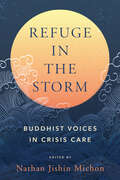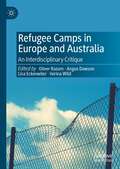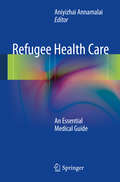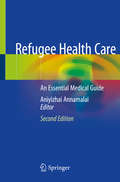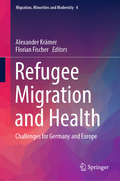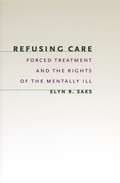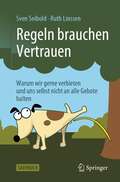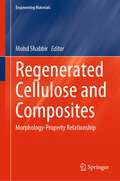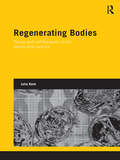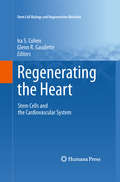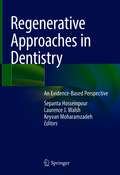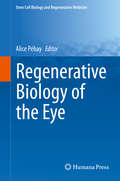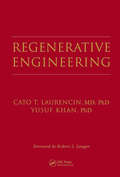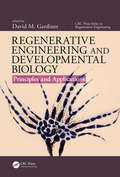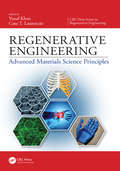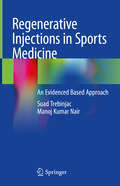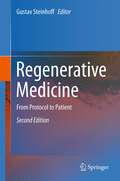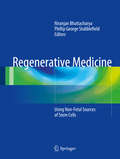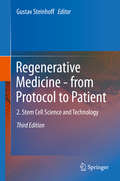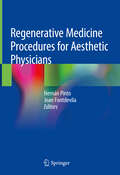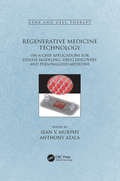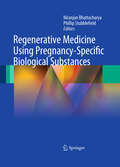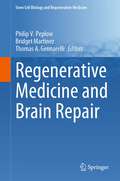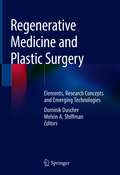- Table View
- List View
Refuge in the Storm: Buddhist Voices in Crisis Care
by Nathan Jishin Michon24 wise and compassionate Buddhist perspectives on crisis care—contemplative practices and spiritual principles to help individuals, families, and communities in crisis and the care providers who support them.Refuge in the Storm presents a wide range of Buddhist perspectives on crisis care. Written by experienced chaplains, spiritual teachers, psychotherapists, pastoral counselors, medical providers, and scholars, the essays in this timely anthology explore a spectrum of personal and global crises: climate chaos, COVID, natural disasters, racism, social inequity, illness, and dying.Drawing on Buddhist principles and practices, these essays offer a wealth of insights for supporting individuals and communities in crisis as well as preventing fatigue and burnout in care providers. The 24 essays in this anthology show readers how to: • Provide spiritual companionship to ill, aging, and dying clients• Infuse crisis care with mindfulness, compassion, prayer, and even playfulness• Prevent burnout with self-care practices rooted in Buddhist principles • Develop self-awareness and self-knowledge as a care provider• Pursue the path of Buddhist chaplaincyEdited by Nathan Jishin Michon—Buddhist priest, chaplain, meditation teacher, and editor of A Thousand Hands: A Guidebook to Caring for Your Buddhist Community—this one-of-a-kind anthology helps care providers develop the compassion, attention, wisdom, and presence needed to support individuals and communities to move through suffering into healing.
Refugee Camps in Europe and Australia: An Interdisciplinary Critique
by Angus Dawson Oliver Razum Lisa Eckenwiler Verina WildThis Palgrave Pivot examines refugee camps in the EU, Australia, and their border zones. The approach is interdisciplinary, comprising perspectives of history, ethics, political science, literature, and health. The book argues that current practice of accommodating refugees is arbitrary and disempowering, ranging from strict regulation within nation states to detrimental conditions in extraterritorial camps. It instead proposes to increase public scrutiny of refugee camps, to enforce existing laws, and to endorse ethical place-making. With its contributions from a wide range of fields, this edited volume will be of interest to academics and students in public health, ethics, sociology, politics, and related fields.
Refugee Children: Towards the Next Horizon
by Charles WattersThe last twenty years have seen unprecedented numbers of refugee children entering Western countries. Many of these children will have experienced the atrocities of war and issues concerning their care and treatment are high on the agenda of research bodies, policy makers and service providers. Refugee Children is the first book to offer a wide ranging analysis of the context of care and the measures taken by nation states and intergovernmental bodies to address perceived problems. Drawing on a detailed examination of practices, the book outlines a model of good practice in the care of refugee children. Topics covered include: the treatment of asylum seeking children at the borders of industrialised countries reception, psycho-social problems, social capital, education, and issues relating to cultural diversity and integration a critical analysis of responses to these problems including the development of special programmes for refugee children, elements of good practice in the field the transfer of good practice between countries implications for the development of services and academic research in this vital area. With a series of case studies examining practices from a number of countries, Refugee Children makes a vital contribution both to the social care literature in this field and to theory and research in refugee and migration studies. As such it is essential reading for academic researchers in a range of disciplines including social policy, education, migration and refugee studies as well as service providers in health care, social care, housing and education. Charles Watters is Director of the European Centre for the Study of Migration and Social Care in the School of Social Policy, Sociology and Social Research at the University of Kent.
Refugee Health Care
by Aniyizhai AnnamalaiRefugees arrive in the United States from different parts of the world and their numbers increase every year. Refugees undergo a medical screening soon after arrival, as recommended by the U. S. Department of State, and it is often primary care practitioners or psychiatrists who usually evaluate these patients at this first visit. Though physicians receive a variable amount of training in cross-cultural medicine, virtually none is in the area of refugee evaluations. Refugee evaluations are different from routine patient evaluations in several significant ways: 1) They are new immigrants from countries where the disease epidemiology is different from the U. S. ; 2) Certain infectious disease processes need to be ruled out upon arrival to prevent the spread of communicable diseases; 3) The prevalence of mental health disorders in refugees is higher than the local population; 4) The medical and psychiatric health problems of refugees are often caused or affected by their past experience with trauma and their current acculturation difficulties; and 5) Significant cultural barriers can arise in the accurate evaluation and treatment of these refugees. Books on refugee health usually are written from ecological and public health perspectives and address generic refugee population issues. There are very few clinical textbooks, and most focus only on mental health. Refugee Health Care is a practical guide providing focused information for busy primary care practitioners, and many of the recommendations in the book apply to all immigrants. This concise pocketbook reviews medical and psychiatric conditions that are essential to know in the evaluation and treatment of refugees.
Refugee Health Care: An Essential Medical Guide
by Aniyizhai AnnamalaiRefugee health is growing as an academic medical discipline. More and more health care providers are coming together to exchange research information, educational curricula and social policies related to refugee health. The number of practitioners attending the annual North American Refugee Healthcare Conference has doubled since 2014. Refugees arrive in the United States from different parts of the world. Refugees undergo a medical screening soon after arrival, as recommended by the U.S. Department of State, and it is usually primary care practitioners who usually evaluate these patients at this first visit. Psychiatrists and other specialists may also evaluate them soon after arrival.Though physicians receive a variable amount of training in cross-cultural medicine, virtually none is in the area of refugee evaluations. There are several major ways that the field has changed. U.S. refugee policies and refugee admission numbers have changed dramatically in the past four years as has the epidemiology of medical conditions because the demographics of refugees have changed. The CDC guidelines for domestic screening have also been modified significantly as some of the screening tests are no longer recommended. Protocols have also been updated for presumptive treatment received by refugees before departure to the United States of other countries. A new chapter on end of life care for refugees has been added to the book. Now fully revised and expanded, this second edition reflects the many changes that have occurred in the field of refugee health since 2014. Refugee Health Care remains the definitive resource for primary care physicians and mental health practitioners who see and evaluate refugees. It is also relevant for medical, nursing and public health students involved with refugee health as well as resettlement agency workers and public health officials overseeing refugee care
Refugee Migration and Health: Challenges For Germany And Europe (Migration, Minorities And Modernity Ser. #4)
by Alexander Krämer Florian FischerThis book focuses on the closely interlinked areas of refugee migration and health. It discusses the main challenges of the recent unprecedented, extremely diverse and mostly unregulated refugee migration wave for Germany and Europe, and offers a broader view of refugee health from a European perspective. Health issues can lead to several challenges for refugees as well as healthcare providers, and as such the book also examines the requirements for the management of migrant populations in terms of medical care and health system adaptations, and includes theoretical aspects of refugee migration and health as well as various perspectives on the latest developments. Lastly, it describes the healthcare system demands and responses for short- and long-term care of refugees.
Refusing Care: Forced Treatment and the Rights of the Mentally Ill
by Elyn R. SaksIt has been said that how a society treats its least well-off members speaks volumes about its humanity. If so, our treatment of the mentally ill suggests that American society is inhumane: swinging between overintervention and utter neglect, we sometimes force extreme treatments on those who do not want them, and at other times discharge mentally ill patients who do want treatment without providing adequate resources for their care in the community. Focusing on overinterventionist approaches, Refusing Care explores when, if ever, the mentally ill should be treated against their will. Basing her analysis on case and empirical studies, Elyn R. Saks explores dilemmas raised by forced treatment in three contexts—civil commitment (forced hospitalization for noncriminals), medication, and seclusion and restraints. Saks argues that the best way to solve each of these dilemmas is, paradoxically, to be both more protective of individual autonomy and more paternalistic than current law calls for. For instance, while Saks advocates relaxing the standards for first commitment after a psychotic episode, she also would prohibit extreme mechanical restraints (such as tying someone spread-eagled to a bed). Finally, because of the often extreme prejudice against the mentally ill in American society, Saks proposes standards that, as much as possible, should apply equally to non-mentally ill and mentally ill people alike. Mental health professionals, lawyers, disability rights activists, and anyone who wants to learn more about the way the mentally ill are treated—and ought to be treated—in the United States should read Refusing Care.
Regeln brauchen Vertrauen: Warum wir gerne verbieten und uns selbst nicht an alle Gebote halten
by Ruth Linssen Sven SeiboldMenschen brauchen Regeln und Menschen rebellieren gegen Regeln. Regeln geben uns Sicherheit und zugleich schränken sie uns ein. Gegen manche Regeln leisten Menschen aktiv Widerstand oder unterlaufen sie heimlich – mit Negativfolgen für alle. Das Sachbuch zeigt, wie man klug mit Regeln und mit Regelbrechern umgeht. Sie erkennen, warum viele Menschen Regeln einhalten und manche Menschen Regeln brechen. Und warum Vertrauen tatsächlich besser ist als Kontrolle. Aus dem Inhalt: Warum man Regeln braucht, warum sich manche Menschen an Regeln halten und andere nicht, welche Regeln wirksam sind, warum Vorbilder unersetzbar sind, wie man Gutwillige bei der Stange hält, wie man mit Regelbrüchen umgeht, wie man böse Fallen vermeidet. Über die Autor:innen: Sven Seibold ist Psychologe und Professor für Wirtschaftspsychologie. Er berät Unternehmen in Fällen von Mobbing, Burn-out, Wirtschaftskriminalität und Wirtschaftsspionage. Ruth Linssen ist Professorin für Soziologie und Recht an der Fachhochschule Münster. Sie berät und schult Behörden und Unternehmen zu den Themen Compliance und Korruptionsprävention.
Regenerated Cellulose and Composites: Morphology-Property Relationship (Engineering Materials)
by Mohd ShabbirThis book highlights the morphology-property relationship of regenerated cellulose materials and composites, as morphology of materials is the key feature and corresponds to associated applications of/to the materials. It is highly essential to assimilate the literature on morphology-property relationship of cellulose materials. Being the most abundant natural polymer on earth and gateway to large number of applications, cellulose is expected to be researched for higher efficiencies. Various books and research articles have targeted the specific morphologies, the respective characteristics and application areas. This book presents literature on morphology-property relationship of cellulose materials and provides a direction to this relationship.
Regenerating Bodies: Tissue and Cell Therapies in the Twenty-First Century (Genetics and Society)
by Julie KentThis exciting book examines how human tissues and cells are being exchanged, commodified and commercialized by new health technologies. Through a discussion of emergent global ‘tissue economies’ the author explores the social dynamics of innovation in the fields of tissue engineering and stem cell science. The book explores how regenerative medicine configures and conceptualizes bodies and argues that the development of regenerative medicine is a feminist issue. In Regenerating Bodies, Kent critically examines the transformative potential of regenerative medicine and whether it represents a paradigm shift from more traditional forms of biomedicine. The book shows that users of these technologies are gendered and women’s bodies are enrolled in the production of them in particular ways. So what is the value of a feminist bioethics for thinking about the ethical issues at stake? Drawing on extensive qualitative field research, Kent examines the issues around donation, procurement, banking and engineering of human tissues, and presents an analysis of the regulatory and policy debates surrounding these practices within Europe and the UK. The book considers the claims that regenerative medicine represents exciting possibilities for treating the diseases of ageing bodies, critically assessing what kind of futures are embodied in tissue and cell based therapies. It will be of interest to a wide range of scholars and students within the social sciences, in health technology studies, bioethics, feminist studies, and gender and health studies.
Regenerating the Heart
by Glenn R. Gaudette Ira S. CohenMedical research made huge strides in treating heart disease in the 20th century, from drug-eluding stents to automatic internal defibrillators. Public awareness of the dangers of heart disease has never been more pervasive. Now, though, ten years into a new millennium, scientists are gearing up for the next great challenges in tackling this pervasive condition. Cell therapy is going to be a key weapon in the fight against heart disease. It has the potential to address many cardiovascular conditions. From heart failure to atrioventricular nodal dysfunction, the young but promising field of cell therapy is set to play a significant role in developing the cures that the upcoming decades of hard work will yield. Regenerating the Heart: Stem Cells and the Cardiovascular System organizes the field into a digestible body of knowledge. Its four sections cover mechanical regeneration, electrical regeneration, cardiac tissues and in vivo stem cell therapies. An array of talented researchers share the fruits of their labors, with chapters covering such crucial issues as the cardiogenic potential of varying stem cell types, the ways in which they might be used to tackle arrhythmias, their possible application to biological replacements for cardiac tissues such as valves, and the varying approaches used in the in vivo evaluation of stem cell therapies, including methods of delivering stem cells to the myocardium. This comprehensive survey of an area of research with such exciting potential is an invaluable resource both for veteran stem cell researchers who need to monitor fresh developments, and for newly minted investigators seeking inspirational examples.
Regenerative Approaches in Dentistry: An Evidence-Based Perspective
by Keyvan Moharamzadeh Sepanta Hosseinpour Laurence J. WalshThis book provides evidence-based information in the field of regenerative dentistry discussing the most recent advances, current clinical applications, limitations and future directions. The coverage encompasses the regeneration of alveolar bone, the dentine-pulp complex, enamel, the periodontium and other tissues associated with the oral cavity. A full description is provided of regenerative approaches in dentistry including regenerative endodontics and tooth repair, regenerative periodontics, regenerative assisted orthodontics, regenerative approaches in oral medicine, and dental tissue derived stem cells and their potential applications. The book is written by an international team of leading experts. It will be beneficial for students, practitioners and researchers in the fields of endodontics, periodontics and implantology.
Regenerative Biology of the Eye
by Alice PébayThis text is a comprehensive look at the current knowledge on stem cell application for vision loss, showcasing different types of stem cells (adult, embryonic, iPSCs) for diseases of the front and the back of the eye. It also highlights data obtained in various models from fish to human, as well as from the bionic eye project for vision regeneration. This volume in the Stem Cell Biology and Regenerative Medicine series is essential reading for stem cell biologists, ophthalmologists, advanced and graduate students, in addition to academics and medical staff who work in these disciplines.
Regenerative Engineering
by Cato T. Laurencin Yusuf KhanDistinct from tissue engineering, which focuses primarily on the repair of tissues, regenerative engineering focuses on the regeneration of tissues: creating living, functional tissue that has the ability to replace organs that are dysfunctional. The challenge of working in an area like regenerative engineering lies, in part, in the breadth of info
Regenerative Engineering and Developmental Biology: Principles and Applications (CRC Press Series In Regenerative Engineering)
by David M. GardinerRegenerative Engineering and Developmental Biology: Principles and Applications examines cutting-edge developments in the field of regenerative engineering. Specific attention is given to activities that embrace the importance of integrating developmental biology and tissue engineering, and how this can move beyond repairing damage to body parts to instead regenerate tissues and organs. The text furthermore focusses on the five legs of the field of regenerative engineering, including: materials, developmental biology, stem cells, physics, and clinical translation. This book was written by leading developmental biologists; each chapter examines the processes that these biologists study and how they can be advanced by using the tools available in tissue engineering/biomaterials. Individual chapters are complete with concluding remarks and thoughts on the future of regenerative engineering. A list of references is also provided to aid the reader with further research. Ultimately, this book achieves two goals. The first encourages the biomedical community to think about how inducing regeneration is an engineering problem. The second goal highlights the discoveries with animal regeneration and how these processes can be engineered to regenerate body parts. Regenerative Engineering and Developmental Biology: Principles and Applications was written with undergraduate and graduate-level biomedical engineering students and biomedical professionals in mind.
Regenerative Engineering: Advanced Materials Science Principles (CRC Press Series In Regenerative Engineering)
by Cato T. Laurencin Yusuf KhanThis book focuses on advances made in both materials science and scaffold development techniques, paying close attention to the latest and state-of-the-art research. Chapters delve into a sweeping variety of specific materials categories, from composite materials to bioactive ceramics, exploring how these materials are specifically designed for regenerative engineering applications. Also included are unique chapters on biologically-derived scaffolding, along with 3D printing technology for regenerative engineering. Features: Covers the latest developments in advanced materials for regenerative engineering and medicine. Each chapter is written by world class researchers in various aspects of this medical technology. Provides unique coverage of biologically derived scaffolding. Includes separate chapter on how 3D printing technology is related to regenerative engineering. Includes extensive references at the end of each chapter to enhance further study.
Regenerative Injections in Sports Medicine: An Evidenced Based Approach
by Suad Trebinjac Manoj Kumar NairThis book sheds new light on the complex area of regenerative injections used in sports injuries and musculoskeletal conditions, pursuing an evidenced-based approach. Largely ignoring orthopedic surgery, which would involve arthroscopic procedures and scaffolding as they are practiced mainly by orthopedic surgeons, the book instead focuses on injection-based treatments that are particularly useful in sports medicine and for musculoskeletal pain conditions. Including evidence from systematic reviews, meta-analyses, and randomized controlled trials, the book provides a comprehensive overview of regenerative injections such as dextrose, platelet-rich plasma and stem cell therapy, along with their history and scientific basis. It also includes detailed information on the preparation methods, steps of the procedure, and clinical conditions most likely to benefit from it. Given its scope, the book offers a valuable tool for all medical practitioners whose work involves painful musculoskeletal conditions, e.g. sports medicine physicians, orthopedists and interventional physiatrists, as well as general practitioners.
Regenerative Medicine
by Gustav SteinhoffRegenerative Medicine is a fastly emerging interdisciplinary field of research and clinical therapies on the repair, replacement or regeneration of cells, tissues or organs in congenital or acquired disease. This new field of research and clinical development focussing on stem cell science and regenerative biology is just starting to be the most fascinating and controversial medical development at the dawn of the 21st century. Viewing the great expectations to restructure and regenerate tissue, organs or organisms the current attempts of scientist and physicians are still in an early phase of development. This new textbook on "Regenerative Medicine - from protocol to patient" is aiming to explain the scientific knowledge and emerging technology as well as the clinical application in different organ systems and diseases. The international leading experts from four continents describe the latest scientific and clinical knowledge of the field of "Regenerative Medicine". The process of translating science of laboratory protocols into therapies is explained in sections on basic science, clinical translation, regulatory, ethical and industrial issues. The textbook is aiming to give the student, the researcher, the health care professional, the physician, and the patient a complete survey on the current scientific basis, therapeutical protocols, clinical translation and practised therapies in Regenerative Medicine.
Regenerative Medicine
by Niranjan Bhattacharya Phillip George StubblefieldThis book represents a major contribution to the emerging science of regenerative medicine using non-fetal sources of stem cells. The Editors, Dr Niranjan Bhattacharya and Professor Phillip Stubblefield, have brought together some of the most pre-eminent scientists working on regenerative medicine to share information on currently ongoing work in this area alongside unpublished observations that will help to shape the contours of future therapies. Regenerative Medicine: Using Non-Fetal Sources of Stem Cells discusses the potential clinical and therapeutic applications using non-fetal stem cells as well as providing instruction on the collection, isolation and characterization of stem cells from various non-fetal sources, such as menstrual blood, adipose tissue, breast milk and uprooted decidual teeth. This book will be an invaluable resource for both active researches and those entering the field. The Editors truly hope that the text will act as a stimulant to professionals and clinical scientists, who may be inspired to further the work of the pioneering scientists who have contributed to this volume.
Regenerative Medicine - from Protocol to Patient
by Gustav SteinhoffRegenerative medicine is the main field of groundbreaking medical development and therapy using knowledge from developmental and stem cell biology as well as advanced molecular and cellular techniques. This collection of volumes, Regenerative Medicine: From Protocol to Patient, aims to explain the scientific knowledge and emerging technology as well as the clinical application in different organ systems and diseases. International leading experts from all over the world describe the latest scientific and clinical knowledge of the field of regenerative medicine. The process of translating science of laboratory protocols into therapies is explained in sections on regulatory, ethical and industrial issues. The collection is organized into five volumes: (1) Biology of Tissue Regeneration, (2) Stem Cell Science and Technology, (3) Tissue Engineering, Biomaterials and Nanotechnology, (4) Regenerative Therapies I, and (5) Regenerative Therapies II. The textbook gives the student, the researcher, the health care professional, the physician and the patient a complete survey on the current scientific basis, therapeutical protocols, clinical translation and practiced therapies in regenerative medicine. Volume 3: Tissue engineering, Biomaterials and Nanotechnology focuses the development of technologies, which enable an efficient transfer of therapeutic genes and drugs exclusively to target cells and potential bioactive materials for clinical use. Principles of tissue engineering, vector technology, multifunctionalized nanoparticles, biodegradable materials, controlled release, and biointerface technology are described with regard to the development of new clinical cell technology. Imaging and targeting technologies as well as biological aspects of tissue and organ engineering are depicted.
Regenerative Medicine Procedures for Aesthetic Physicians
by Hernán Pinto Joan FontdevilaThis book presents the state-of-art in regenerative procedures currently applied by aesthetic physicians, plastic surgeons and dermatologists. It is divided into two parts, the first of which provides a detailed introduction to aesthetic medicine and the aging process. The second part, in turn, addresses the current status of techniques and technologies with regard to autologous grafts, covering fat transfer, blood grafts, skin grafts and stem cells. The book examines the surgical applications of these grafts, as well as potential side effects and limitations. Therapy combinations and outcomes round out the coverage. Aesthetic physicians, plastic surgeons and dermatologists interested in performing regenerative procedures for aesthetic purposes will find this book to be a valuable guide.
Regenerative Medicine Technology: On-a-Chip Applications for Disease Modeling, Drug Discovery and Personalized Medicine (Gene and Cell Therapy)
by Anthony Atala Sean V. MurphyMiniaturization in the fields of chemistry and molecular biology has resulted in the "lab-on-a-chip." Such systems are micro-fabricated devices capable of handling extremely small fluid volumes facilitating the scaling of single or multiple lab processes down to a microchip-sized format. The convergence of lab-on-a-chip technology with the field of cell biology facilitated the development of "organ-on-a-chip" systems. Such systems simulate the function of tissues and organs, having the potential to bypass some cell and animal testing methods. These technologies have generated high interest as applications for disease modeling and drug discovery. This book, edited by Drs. Sean Murphy and Anthony Atala, provides a comprehensive coverage of the technologies that have been used to develop organ-on-a-chip systems. Known leaders cover the basics to the most relevant and novel topics in the field, including micro-fabrication, 3D bio-printing, 3D cell culture techniques, biosensor design and microelectronics, micro-fluidics, data collection, and predictive analysis. The book describes specific tissue types amenable for disease modeling and drug discovery applications. Lung, liver, heart, skin and kidney "on-a-chip" technologies are included as well as a progress report on designing an entire "body-on-a-chip" system. Additionally, the book covers applications of various systems for modeling tissue-specific cancers, metastasis, and tumor microenvironments; and provides an overview of current and potential applications of these systems to disease modeling, toxicity testing, and individualized medicine.
Regenerative Medicine Using Pregnancy-Specific Biological Substances
by Phillip Stubblefield Niranjan BhattacharyaThe proposed book is a holistic review of the clinical use of placental substances, amniotic fluid, the umbilical cord and its contents. It is intended to be a unique presentation of the current advances as well as also discussing the future applications of these substances. Attention is yet to be focused on the widespread clinical use of pregnancy-related biological substances. The aim for this book is to inform clinicians of the use of such materials and increase awareness of their therapeutic benefits. As such, this reference resource will be of great value to hematologists, rheumatologists, cardiologists, transplant technologists and all involved in regenerative medicine.
Regenerative Medicine and Brain Repair (Stem Cell Biology and Regenerative Medicine #75)
by Philip V. Peplow Bridget Martinez Thomas A. GennarelliThis book presents the latest knowledge, trends, and advances in cell transplantation and innovations in developing microspheres, 3D biomaterial constructs to enhance transfer, and cell survival to specific regions of the brain. Neurodegenerative diseases and brain injury are increasing. Medications currently only temporarily reduce some of the symptoms but do not cure or delay progression of the disease. Development of effective treatments dramatically improves the independent living and quality of life of patients. Cell transplantation strategies offer an approach to facilitating brain repair, but efficacy is often limited by low in vivo survival rates of cells that are injected in suspension. Transplanting cells that are attached to or encapsulated within a biomaterial construct has the advantage of maintaining cell-cell and cell-material interactions and improving cell survival in vivo. Biomaterials that have been used in preclinical studies to assist with in vivo cell transfer and survival include heparin-chitosan microspheres, poly(lactic-co-glycolic acid) microspheres, RADA 16 microspheres, poly(desaminotyrosyl tyrosine ethyl ester carbonate) microscale scaffolds, carbon nanotubes, collagen-chitosan scaffolds, poly(L-lactic acid) scaffolds, agarose hydrogels, gelatin methacrylate hydrogels, and agarose micro-columns with an extracellular matrix interior. Incorporating growth factors (e.g., glial-derived neurotrophic factor, neurotrophin 3) into the biomaterial constructs increased cell survival and incorporation into the host tissue. International experts in the fields of both experimental and clinical neurological research contribute chapters to this book and discuss the latest achievements in cell transplantation and matrix-assisted cell transfer/survival technologies for diseases such as Alzheimer’s disease, Parkinson’s disease, and brain injuries such as stroke and traumatic brain injury. It is envisaged that research findings in experimental animal models of Alzheimer’s disease, Parkinson’s disease, traumatic brain injury, and stroke promote clinical trials using biomaterial-assisted transfer of cells.
Regenerative Medicine and Plastic Surgery: Elements, Research Concepts and Emerging Technologies
by Melvin A. Shiffman Dominik DuscherThis book discusses the current research concepts and the emerging technologies in the field of stem cells and tissue engineering. It is the first authoritative reference documenting all the ways that plastic surgical practice and regenerative medicine science overlap or provide a road map for the future of both specialties. The Editors have provided a valuable service by gathering in one place the leading voices in these two fields in clear and concise manner. Divided into five parts, the book opens with a description of the elements of regenerative medicine including definitions, basic principles of soft and bone tissue regeneration, biomaterials and scaffolds. Current research concepts are explored in the second part of this book, for example mechanotransduction and the utility of extracellular vesicles. In the third part, the editors present the emerging technologies and highlight the novel perspectives on bionic reconstruction and biomimetics in surgery and regenerative medicine. Part four deals with translational aspects including practical information on moving scientific findings from bench to bedside. The final part then describes in detail applications in clinical plastic surgery. Written by leading experts this book is an invaluable resource for researchers, students, beginners and experienced clinicians in a range of specialties."In your hands is a comprehensive encyclopedia of two rapidly converging fields. Drs Duscher and Shiffman have done an outstanding job of highlighting the interdependent relationship between plastic surgery and regenerative medicine. Ultimately, this is to the benefit of both fields." - Geoffrey C. Gurtner, MD, FACS Johnson and Johnson Distinguished Professor of Surgery Professor (by courtesy) of Bioengineering and Materials Science Inaugural Vice Chairman of Surgery for Innovation Stanford University School of Medicine
